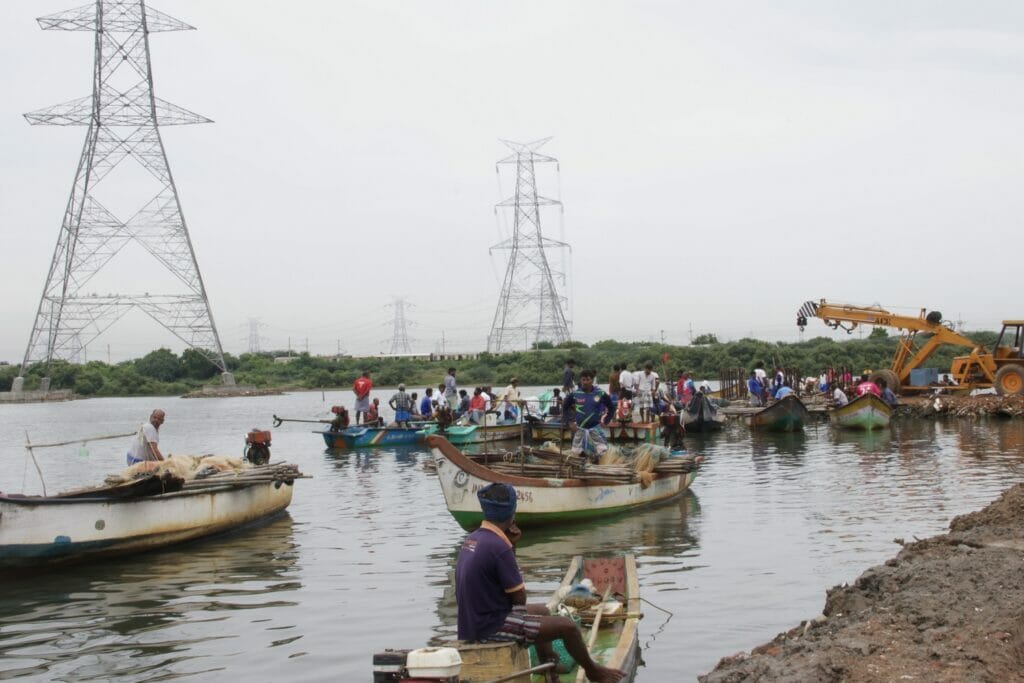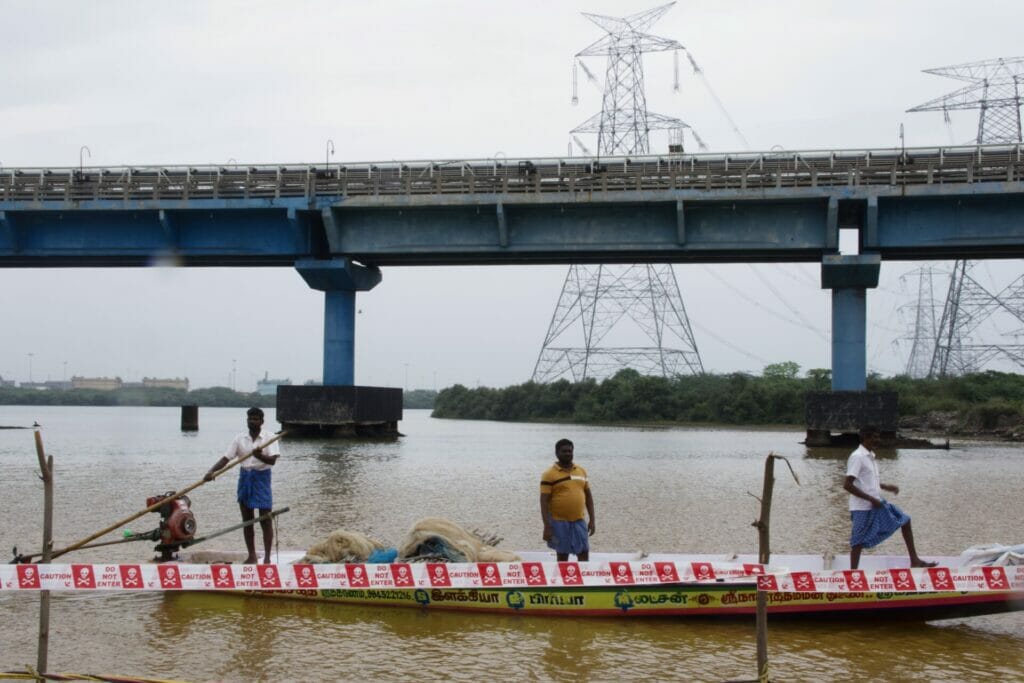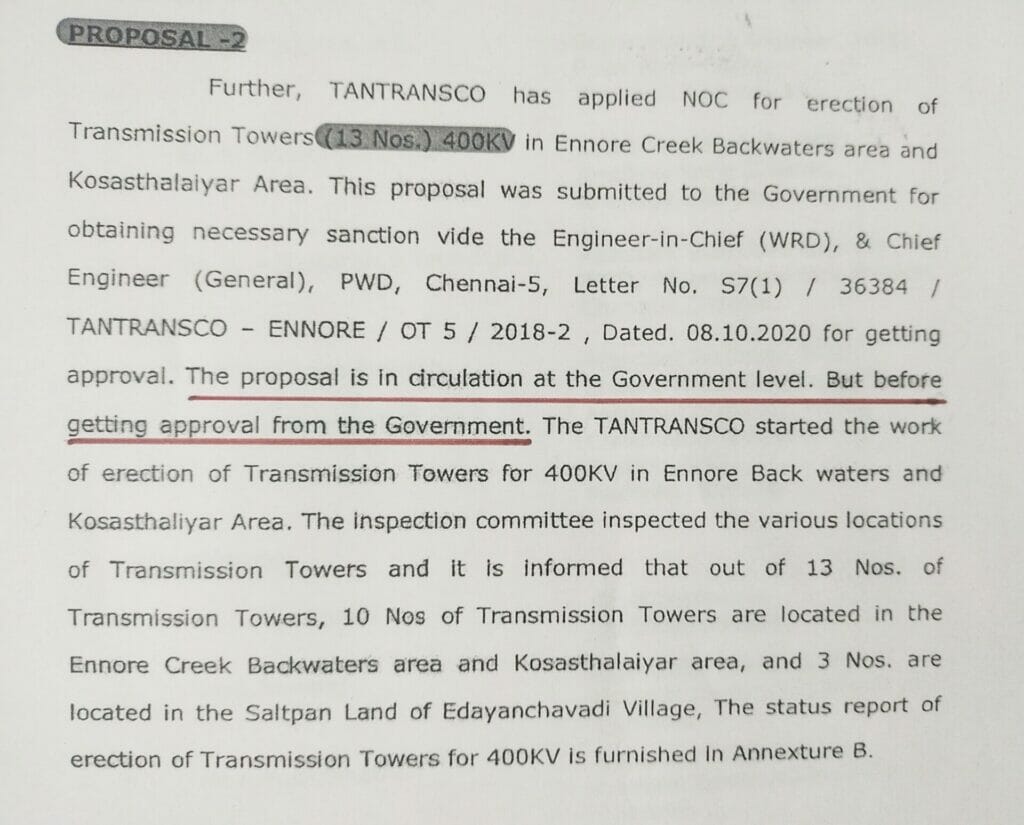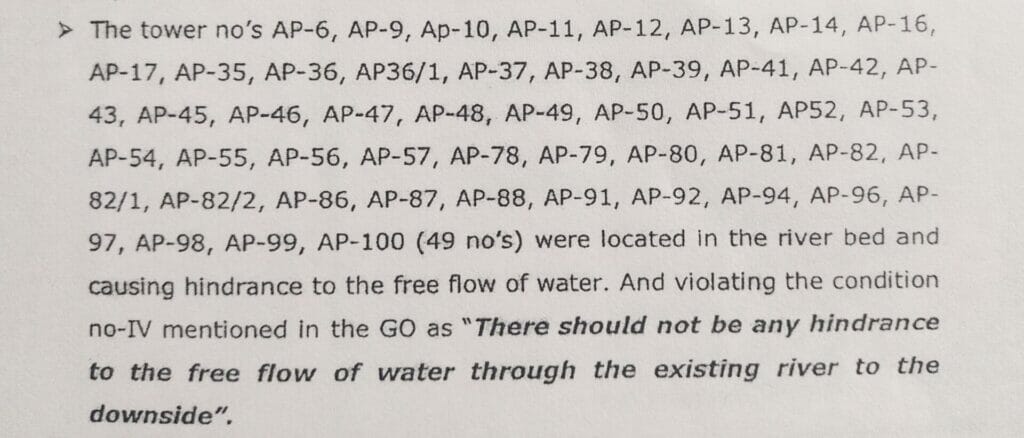At around 10 am on July 26, the loud noise from a construction site inside the Kosasthalaiyar river came to a halt. The construction workers slowly walked out of the river, while the inland fishers from the villages around Ennore surrounded the construction site with their boats.
It was an unusual protest, one without black flags or loud slogans. While many of the fishers stayed in their boats, a few of their representatives came down to explain the reason for their protest.
Soon the construction site below the Ennore Creek Bridge was packed with hundreds of police personnel.
The protest by the fishers is against the ongoing move by the Tamil Nadu Transmission Corporation (Tantransco) has decided to install a power transmission tower inside the Ennore Creek Backwaters area of the Kosasthalaiyar River.
The fishers allege that Tantransco has also dumped the construction debris to lay an approach road from a point below the Ennore Creek Bridge towards to point inside the river where the transmission tower is to be installed.
Raising their concerns about how the installation of a transmission tower and dumping construction debris in the river will affect the river as well as their livelihood, the fishers of eight villages in the region staged a protest.
This includes the fishing hamlets of Nettu Kuppam, Thazhan Kuppam, Kattu Kuppam, Ennore Kuppam, Mugathuvara Kuppam, Sivanpadaiveethi Kuppam, Periyakuppam and Chinna Kuppam.
Notably, these fishers have also staged more vigorous protests against the said project in the past but to no avail.

Read more: Industrial pollution in Chennai: Through the lens of the toxic tour
What is the project about?
The Tantransco sent three proposals for the installation of transmission towers in Ennore Creek Backwaters and Kosasthalaiyar River.
According to the first proposal, there will be seven transmission towers connecting the proposed North Chennai Thermal Power Station Stage-3 to the proposed North Chennai 765 KV pooling station.
The second proposal has 13 transmission towers for 400 KV, of which 10 are located in the Ennore Creek Backwaters areas of the Kosasthalaiyar area, while three others are located in the Saltpan Land of Edayanchavadi village.
According to the third proposal, there will be 74 transmission towers with a 765 KV DC line from the proposed North Chennai 765 KV pooling station to Ariyallur (Villupuram) 765/400 KV substation. All 74 towers were erected before 2018.
Of the three proposals, as many as 20 transmission towers (7 transmission towers with 765 KV and 13 transmission towers with 400 KV) are located in the Ennore Creek Backwaters area of Kosasthalaiyar River.
Impact on the ecosystem and the fishers around Ennore
The fishers protest against the installation of the towers in the backwaters and the river highlights both the impact of the transmission towers on the ecosystem and their livelihood.
“Firstly, Tantransco has obtained permission to install this particular transmission tower in a land area that has a different survey number. However, they have been carrying out construction works inside the river which they do not have permission for,” says Venkatesh, a fisherman from Ennore Kuppam.
Secondly, Tantransco has dumped construction debris to lay an approach road to carry out the construction work.
“This area is called ‘Paadu’ – meaning fishing ground. We have demarcated the fishing zones using GPS by obtaining permission from the central government but the State Coastal Zone Management Authorities have failed to mark the fishing zones and fish breeding areas on the Coastal Zone Management Plan. The National Green Tribune has also ordered the State Government to declare Ennore Creek and the backwaters as a ‘notified wetland’. However, the State has also failed to do it. These are important not only for the fishers of Ennore and the surrounding areas but also for the people of Chennai as any damage to Ennore Creek will result in increasing the flood risks of the city,” says Kumaresan, a fisherman from Kattu Kuppam.

While the illegal construction will affect the people of Chennai at large, fishers of Ennore and the surrounding villages whose livelihoods depend on the Kosasthalaiyar River and the Ennore Creek Backwaters, are the ones who are affected the most.
Explaining this in detail, Madhanagopal, yet another fisherman, says, “Unlike other fishermen who fish in the sea using fishing nets, the inland fishers do not fish by throwing nets in the river. We get into the river to collect the fish. During such times, the construction materials dumped in the river tears the skin of the fishers.”
These injuries are in addition to an array of health issues ranging from dermatological conditions to cancer caused by industrial pollution in the locality.
Further, the construction debris dumped in the river also damages the boats of the fishers.
Read more: Women of Ennore are living testimony to the many costs of pollution
Explaining the possible risks of installing the power transmission lines inside the river, Kumaresan also points out that if the transmission lines fall into the water, the fishers who have to get into the water for fishing will be electrocuted.
“People in Ennore and the surrounding regions are already dying of various health issues and loss of livelihood. Electrocution is one last thing we would want now,” he says.
“We are not against the growth of the nation that depends on the manufacturing of electricity. All that we seek is to consider and include our growth in the process as well. We do not have any issues if they install the same towers on the land area. But, if the same is installed in a fishing breeding, how will we survive?” asks Kumaresan, demanding to remove the construction debris with immediate effect.
He also says that they will also launch a legal battle against the project for which their inputs and objections as key stakeholders in the area was not considered.

When asked if any public consultation was conducted before implementing the project, all the fishers reply in negative. To back this up, they also show a response to a query filed under Right to Information Acr, 2005 by N Durga in which the Tamil Nadu State Rural Livelihood Mision – District Mission Management Unit of Tiruvallur District says ‘no public consultation was held with the fishers to ascertain the nature of the damages due to construction of the towers.’
Key findings on the violation of law by Tantransco
Not only does the information sought through RTI support the fishers but also an inspection report by the Water Resource Department (WRD) dated July 14, 2022, proves how Tantransco has violated several norms in the erection of the transmission towers.

According to the WRD inspection report that was shared by the fishers with us, Tantransco applied to the Public Works Department (PWD) and WRD to obtain NOC for the erection of 13 transmission towers (400 KV) in the Ennore Creek Backwaters area and Kosasthalaiyar area (proposal 2) on October 8, 2020.
The WRD report claims that Tantransco started the work for installing the towers before getting approval from the government.
“The proposal is in circulation at the government level,” says the report.

Further, a government order dated November 26, 2018, that lays the terms and conditions of PWD and WRD emphasises, “There should not be any hindrance to the free flow of water through the existing river to the downside.”
The WRD report observes that as many as 49 transmission towers installed as part of proposal 3 have violated this norm.
“The 49 towers located in the riverbed cause hindrance to the free flow of water,” says the report.

Further, 13 towers erected in the bunds of Kosasthalaiyar River have ‘disturbed and damaged the bunds’ which is against the aforementioned GO that says, “While constructing the pillar in front of the bund toe, the bund will be protected from the erosion of which, cement concrete block of rough stone revetment is to be provided with the wall in the slope of bund for both the sides of pillar for a length of 15 m, thereby the erosion will be protected.”

The GO also has a condition that reads as follows: “After the completion of the work, the waste materials used should be removed completely. After the completion of the work, the damaged portion of the river structure, if any, should be set straight and restored to the original condition.”
However, the WRD report points out that the construction materials debris and dumped soil damaged the river structure and were also not removed after construction was over. Thus, yet another violation of the condition mentioned in the GO.
Further, the WRD report also emphasises that a comprehensive study has to be made to assess the flood-carrying capacity and deviation in the tidal flow of the waterbodies like Buckingham Canal and Kosasthalaiyar and backwaters of Kosasthalaiyar River which has occurred due to the construction of transmission towers at the Ennore wetland complex.
The report also suggests that the width of the Kosasthalaiyar River at specific locations where the transmission towers are laid should be widened to the previous existing linear waterway as the installation of the towers decreases the linear waterway of the river. In addition to this, flood protection walls should also be constructed to ensure free flow in the river.
Protecting the fishers of Ennore
Following a similar protest in 2021, an inquiry was conducted by the District Magistrate and the District Collector Dr Alby John Varghese on November 3, 2021. During the enquiry, the representatives of the Ennore Area Eight Fishermen Village Panchayat Sabai stated that their livelihoods will be affected by the installation of the transmission towers.
To compensate for the loss of livelihood, the representatives demanded permanent jobs for the villagers in Tantransco.
While Tantransco says that the demand has been forwarded to the government for further action, to this day the fishers have not been given any update on their demand.
Tantransco also stated that the erection of the towers ‘will not affect the passage of boats and the concern expressed by the fishermen that their livelihood will be affected is untenable’.
While the fishers of Ennore and the surrounding villages demanded the officials from the Tantransco and the district collectorate who attended peace talks on July 26 to stop the construction works immediately and remove the construction debris, they were hesitant to meet their demands. At least four rounds of talks went on between the representatives of the fishers and the officials.
The officials offered the fishers a meeting with the Tiruvallur Collector on July 28 but did not agree even to stop the construction works for a day.
“Believe in my words and please cooperate with us. If all the fishers are okay with us using the sandbags for laying the approach road instead of construction debris, we will work on it,” said the officials to the fisher folks.
“For ages, we have been asked to believe in their words. Not for once did they attempt to understand the impact of these violations on our lives and livelihoods, let alone nature itself. All we ask now is for them to return our river to us,” says the fishers of Ennore.
With much evidence on paper about the violations and the repeated plea by the fishers, the question remains if the government will wake up to their very real concerns and prevent damage to the river, their lives and livelihood.
